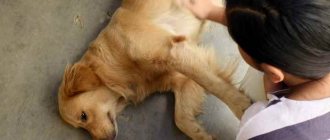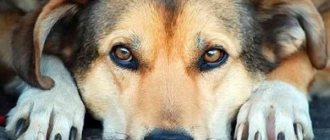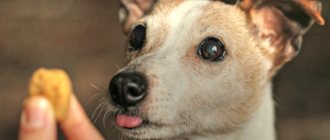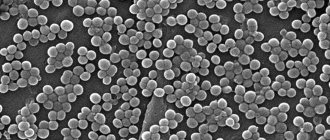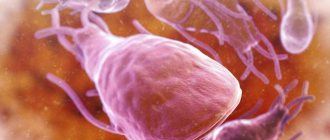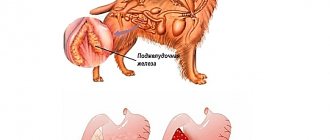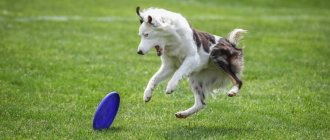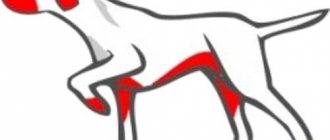Most external parasites that live on the surface of the body are carriers of infections. Fleas and ticks are most often found on pets, but there are other, no less dangerous pests. These include representatives of the lice beetle family, which cause trichodectosis in dogs. Despite the similarity of symptoms with flea and tick infestations, this parasitic disease has a number of differences regarding its causative agent.
Lice eaters in dogs and what they look like
Lice-eating lice are classified as lice that parasitize four-legged pets. The length of these yellowish-gray insects is no more than 2 mm even after maturing to a sexually mature individual. When viewed with the naked eye, they can easily be confused with regular dandruff.
Unlike other lice, lice are wingless. They cling to their host with hook-shaped jaws and strong claws. These parasites feed on keratinocytes, that is, hair and skin cells.
Hair lice are striking in their fertility. One individual can lay up to 100 eggs, which go through the entire development cycle in just 28 days. Without timely treatment, the colony of parasites grows rapidly, causing severe itching in the infected animal.
What do parasites look like?
The presence of lice eaters on a dog’s body provokes a dangerous disease called trichodectosis. And before you start fighting parasites, you need to know what they look like.
The lice eater is a small insect that parasitizes the body of warm-blooded animals. Its flat, flattened body does not exceed 2 mm in length and most often has a grayish-transparent or pale yellow tint. Therefore, detecting a pest is not always easy. Externally, lice eaters are very similar to lice. Their distinguishing feature is their head. In wingless insects it is quadrangular in shape and much larger than the chest. Below you can see what lice eaters look like in dogs in the photo.
lice eaters
The pest feeds on particles of skin and fur, which is why it is also popularly called skin beetle, lice beetle or itch. It is also attracted to the dried blood that forms as a result of the animal's grueling scratching.
The reproduction of parasites is quite active: one female is capable of laying about 6-7 dozen eggs, which she firmly attaches to her hair with the help of an adhesive liquid. That is why it is not easy to wash off lice-eater eggs with water or comb them out. After 5-10 days, lice eater larvae emerge from them, which molt at least three times before becoming sexually mature individuals. This process takes them about a month.
Difference from other ectoparasites
The symptoms and methods of treating scabies mites, lice mites and fleas in dogs are similar, but the differences between these ectoparasites are clearly visible in the photo. The size of the lice beetle is much larger than that of a tick, and its head is wider than a flea.
Another difference is the way they eat. Hair lice live strictly on the surface of the skin, and their mouthparts are not adapted for sucking blood. Despite this, they happily feast on the lymph that appears from the wounds as a result of scratching.
Due to the lack of wings and poor jumping ability, lice eaters do not strive to leave the body of their owner. This distinguishes them from fleas, which love to savor different types of blood and often move on to new victims.
Symptoms of a dog infection
When a dog is struck by a hairworm, it is initially not visible, because all their movement and active growth of the family occurs in the undercoat, in the depths . The animal can only itch and whine, this is how the first negative manifestations can be determined. Then usually all the dog's fur is examined down to the very depths of its fur in order to find the source of parasites. Symptoms of a more advanced state of the disease are the following:
- Initially, the fur becomes dull and ruffled.
- White grains, very similar to dandruff, are visible to the naked eye in the fur .
- The animal itches and whines endlessly.
- Some areas of the skin become bald .
Nervousness during the day and restless sleep at night can haunt a four-legged friend with severe degrees of damage. Because of this, over time, the animal constantly drinks a lot of water and eats little . The wounds on the skin are constantly chewed by the pet, and the opened wounds become self-infected with various infections and harmful bacteria. If left untreated, the animal may become completely bald and die from excess bacteria in the body and infections that enter through the wounds.
In general, such a creature is reluctant to live with people, and is very fond of animal fur, because humans do not have such a thick undercoat as is found in dogs or cats.
Danger of infection and complications
Any pet can become infected with trichodectosis, so the patient must be isolated during treatment. Despite this, direct transmission of parasites occurs only some time after infection. Until this moment, small pests are in no hurry to change their owner.
It is also worth noting that a dog's lice eater is different from a cat's. Each of these ectoparasites gravitates toward a specific type of animal and tends to leave the body of the “wrong” host. If there is a cat living in the house, then the greatest danger to it is not the lice eater, but the diseases it carries.
Thanks to their “gnawing” mouthparts, lice lice remain undetected for a long time. Their bites are not as painful as those of fleas, so the symptoms of infection at the initial stage are almost invisible. For this reason, trichodectosis is often complicated and leads to:
- secondary infection with fungi and bacteria that freely penetrate combed wounds;
- allergies provoked by waste products of pests;
- exacerbation of chronic pathologies arising from a weakened immune system;
- exhaustion and anemia;
- helminthic infestations that develop when eggs and larvae of helminths are transmitted through lice beetle bites.
The last complication is observed more often than others. The thing is that when biting the itchy areas, the helminths go straight into the mouth.
The danger of lice for dogs
The consequences of infection can be quite serious. In addition to the harm that lice eaters directly cause to animals through their vital activity, they often become intermediate hosts of helminths and pose a danger as a natural reservoir of internal parasites. Also, the parasitism of lice eaters contributes to the development of various skin infections. The most serious risk when a dog is parasitized by Trichodectes canis is infection with cucumber tapeworm. Cat and dog lice eaters, like fleas, are intermediate hosts of the tapeworm Dipylidium caninum. A dog becomes infected by ingesting an infected parasite while biting its fur while trying to relieve severe itching caused by the parasites. People who are in close contact with pets can also become infected with dipilidia. Infestation with lice eaters can lead to severe exhaustion of the dog. Animals cannot eat normally, become nervous, and cannot sleep peacefully. Puppies may be delayed in growth and development, and gain weight poorly. If the infestation is severe, dogs may develop anemia. The parasitic activity of lice eaters leads to secondary skin problems. Self-injury during scratching leads to inflammation of the skin and can be complicated by pyoderma (the proliferation of microflora on the dog’s damaged skin). While scratching and biting the dog damages the skin, open wounds are formed into which microbes living on the skin and pathogenic microorganisms enter.
Routes and sources of infection
The main mechanism of transmission of the pathogen is contact. Lice eaters appear in puppies from an infected mother, since in the first 2 months the babies are under strict quarantine. In adulthood, infection occurs through sexual contact, licking, sniffing, fighting and playing together.
In addition to direct contact with a sick animal, an indirect transmission mechanism is also possible, that is, through hygiene items, toys, dishes and outdoor shoes.
Infection through rodent carriers is even less common. Cats that hunt mice and rats are usually infected in this way.
The risk group includes residents of dog shelters. Due to the crowded conditions, only one infected person is enough for a mass epidemic. Also, the likelihood of infection increases a weak immune system due to
:
- high level of humidity, increasing the pathology of the respiratory system;
- poor diet;
- immunodeficiency;
- too young or old;
- neglect of hygiene.
Trichodectosis is characterized by seasonality. The greatest activity of parasites is observed in autumn and winter.
Main symptoms
Despite the mild symptoms and small size of the pathogen, an attentive owner can easily detect it. The main changes concern the behavior and appearance of the dog. These include:
- loss of activity, poor appetite and irritability;
- intense itching, affecting the quality and duration of sleep;
- the appearance of dandruff and deterioration in the quality of wool (fragility, the appearance of tangles) as a result of active exfoliation of the epidermis;
- focal hair loss at the base of the tail, on the inner thighs, head and ears, accompanied by inflammation and redness of bald spots.
If you notice these symptoms, be sure to do a small test. Point the switched-on lamp at your pet and warm its skin for 10 minutes. Pooh-eaters love high temperatures, so they will definitely get closer to a heat source. At this point they can be seen under a magnifying glass.
Once you are sure you have trichodectosis, immediately make an appointment with your doctor. All insecticidal preparations are very toxic, so their dosages and duration of administration are selected individually.
Infection process and symptoms
There is only one way of infection by lice eater - through direct contact:
- Contact with an infectious animal. Most often, when interacting with stray animals, pets become infected with lice and fleas.
- Even if we exclude any interaction between a domestic dog and any stray animals, there is still a risk of infection. Lice eaters are too small to be seen with the naked eye, and a dog owner may unknowingly carry the parasite on their hands, shoes or clothing.
- From mother to puppy, with direct contact.
If an animal is infected, but there are still few parasites and they are not active enough, it is very difficult to detect them. But when lice eaters multiply, the disease can be identified by the following symptoms:
- The dog experiences severe itching, which is why it scratches constantly.
- The presence of light flakes in the dog's fur, similar to dandruff. Lice eaters are sedentary parasites, but upon very careful examination you can see how these “flakes” move.
- The dog's fur becomes dull, brittle, becomes matted and sticks together.
- Partial baldness may occur - the inner thighs and base of the tail are especially susceptible to this.
- When there are a lot of parasites and they cause severe discomfort to the pet, the dog may lose its appetite, become apathetic, and lose weight.
Can a person become infected?
The lice bug in dogs is transmitted to humans and other domestic animals. But in both cases, the only real danger is allergic reactions and helminth infection. On human skin, the parasite dies within 2-3 hours. The cause of death is poor fur and too low body temperature.
How to get rid of lice in dogs
After taking a scraping, the veterinarian determines the severity of the disease and explains how to treat lice in dogs. At the initial stage, they limit themselves to insecticides, and at an advanced stage, they add antibiotics and antimycotics that fight secondary infection.
Treatment with insecticides is carried out twice. At the first stage, all adult individuals are killed, and at the second, the larvae hatched from the eggs.
Shampoos
Shampoo is the most gentle type of insecticidal preparations, but this is also its disadvantage. It washes off too quickly, so it is effective only for mild forms of trichodectosis. In addition to destroying the pathogen, it improves the condition of the coat and relieves itching.
Sprays
Spray the spray directly onto the coat, avoiding licking the product until completely absorbed. Otherwise, the pet may be poisoned. Direct inhalation should also be avoided. To do this, it is recommended to use a protective mask during processing.
Drops
The most common form of anti-lice preparations for dogs is drops. They are made from natural oils or chemicals that kill parasites.
Another feature of this product is its long-lasting effect. When applied to the skin, it protects the animal from pests for 2 months.
Ointments
For frequent use in case of extensive damage, ointments are prescribed. They are applied twice a day after shampooing. Such drugs are characterized by the least toxicity and rarely cause allergies.
Pills
The duration of action of the tablet form is up to 3 months. When the tablet is swallowed, the active substances enter directly into the blood, so the parasites die soon after the bite.
Collars
Insecticidal collars are effective in preventing trichodectosis, flea and tick infestations. To repel parasites, they are impregnated with special chemicals, which often causes allergies. In case of hair loss and redness of the skin at the contact site, it is recommended to replace the collar with a safer analogue.
Folk remedies
Folk remedies for hairworms for dogs include various herbal decoctions based on string, chamomile and celandine. A sick pet is bathed in them until the symptoms disappear. This method of treatment is suitable for puppies and animals with sensitive skin who are not allergic to the listed plants.
Treatment of lice-eater infections in dogs
The main method of treating lice in dogs is the destruction of parasites using insectoacaricidal agents. To destroy the larvae, they use products that are used to treat flea infestations. Drops and sprays with fipronil, selamectin, imidacloprid (used only for dogs, toxic for cats), pyriprol (used only for dogs and not for cats) and other antiparasitic agents that are used to combat external ectoparasites are used. Treatment is carried out at intervals of 14 days.
It is important not to use ectoparasite treatments containing pyrethroids to treat dogs or treat premises if there is a cat living in the house with a dog, since pyrethroids are toxic to cats and can cause severe poisoning in them. In order to get rid of lice, it is necessary to carefully treat the external environment - the space where the dog lives.
To prevent recurrence of the disease, all animals that are in contact with a dog infected with lice should be treated, despite the fact that not all animals living with an infected person have clinical signs of the disease. Since the entire life cycle of the lice eater lasts from 14 to 21 days, treatment should continue for at least 14 days, and for the next 14 days after the main course of treatment, bathing with medicated shampoo is carried out. On average, the full course of treatment lasts about 30 days.
Since lice-eaters often affect puppies, when choosing a drug it is important to take into account not only the body weight, but also the age of the babies. When lice eaters infect small puppies or kittens, pregnant, lactating, malnourished or convalescent animals, it is important to use a special remedy that is approved for the smallest and most weakened patients. As a rule, in such cases, fipronil-based sprays or drops are used.
Lice eaters are usually easily killed by insecticides, so getting rid of them is usually not difficult. If the dog is kept in an apartment, then at the beginning of the course of treatment, bathing with anti-parasitic shampoo is used and after 3-5 days the drug against fleas and ticks is applied in the form of drops to the withers. When bathing your dog, it is important to hold the foam of the medicated shampoo on the coat for at least 5–7 minutes.
Dosage and use of medications
The treatment course takes at least a month, so it is very important to follow all the veterinarian’s recommendations. If you neglect treatment until all parasites are destroyed or exceed safe dosages, you can harm your pet.
When using medications, be sure to adhere to the following rules:
- Do not rush to wash off shampoo applied to wet fur. The effect appears only after a few minutes, so rub it thoroughly into the skin and leave it there for a while. Pay special attention to heavily soiled areas with tangles. They require more detergent to clean.
- After rinsing off the shampoo, dry the coat thoroughly and comb it through with a comb. This will help get rid of a significant part of the pests.
- When spraying sprays, try to avoid getting them into the eyes and other mucous membranes.
- Apply drops strictly to the withers or along the line of the spinal column. In these areas, the animal will not be able to lick them, but for safety it is better to wear a protective collar.
The treatment is carried out in several stages with a weekly or two-week interval. If the symptoms disappear almost immediately, do not rush to rejoice and cancel the prescribed medications until you are re-examined at the veterinary clinic.
Symptoms and signs
The rapid proliferation of parasites affects the dog’s behavior. An attentive owner should notice the invasion if he knows its signs.
The first symptoms of the appearance of a lice eater:
- Severe itching
- Nervous behavior
- The appearance of scratches and wounds
- Defective coat appearance
- The appearance of bald patches in the hairline
- "Dandruff"
- Signs of mucosal anemia
Samoyed dog
Attention! If you have any of the above symptoms, you should take your animal to a veterinarian. Once the diagnosis is confirmed, treatment will be prescribed.
It is also possible:
- apathetic behavior
- refusal of active games,
- sleep disturbance,
- anxiety,
- refusal of food.
The dog is constantly itching and chewing off its fur until wounds form. A pet may refuse to follow commands, become absent-minded, or lose body weight - all these are sure signs of infection with the lice-eater parasite.
Handling your pet's personal belongings and disinfecting your home
Leaf bugs that have left the fur can hide in any household items, so the fight against them cannot be done without thorough disinfection. All horizontal surfaces must be treated with insecticides or herbal infusions.
Particular attention should be paid to dog toys and bedding. They should be washed in hot water with insecticidal shampoo or treated with steam, and then thoroughly frozen on the balcony. In summer, the required temperature can be found in the freezer. To destroy heat-loving pests, it is enough to keep washed items there overnight.

